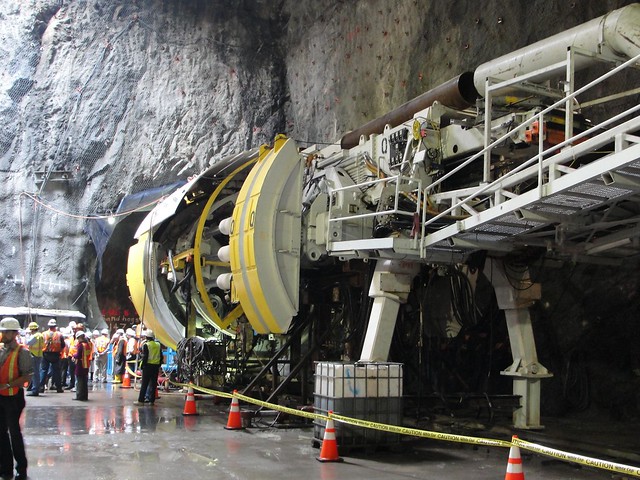It’s now been over 48 hours since New Jersey Gov. Chris Christie announced the end of the ARC Tunnel project, and the reactions are still coming fast and furious. Let’s dive in.
New York pols put in call for unused billions for MTA support
We’ll start with the juicy stuff. Since Christie sacrificed $3 billion in federal financing when he torpedoed the tunnel, the feds have some money to spend. Not missing a beat, New York and the MTA are jumping into the fray. With a $10 billion hole in its capital budget and perennial operating deficits, the MTA is going to make a play for some of the money, and both Sen. Kirsten Gillibrand and Manhattan Borough President Scott Stringer have called upon more federal contributions to both the Second Ave. Subway and the East Side Access project. “We will certainly stake our claim,” MTA CEO and Chair Jay Walder said.
Putting the Port Authority dollars to use
The other $3 billion contribution — this one from the Port Authority — is now sitting unused as well, and the Tri-State Transportation Campaign has a solution: Spend some of the money on improving cross-Hudson bus service. Here’s their thinking:
According to ARC’s final Environmental Impact Statement, the project would have shifted daily 11,530 trans-Hudson bus trips and 31,590 trans-Hudson car trips to rail by 2030. Assuming an average bus capacity of 35 passengers, more than 1,230 additional buses will be needed to meet that demand in the absence of ARC. Another 473 buses will be needed to accommodate the baseline projected increase of 16,538 bus trips that would occur even with the tunnel. That’s another 1,703 buses needed by 2030 to accommodate this growth in cross-Hudson trips.
Currently, NJ Transit has a total of 2,125 buses statewide. If half of new trips are on NJ Transit buses (with the other half on private carriers), the agency would have to increase its existing bus fleet by at least 850 buses, or 40%. That’s a major investment.
And with the Lincoln Tunnel’s Express Bus Lane and the Port Authority Bus Terminal (PABT) already at or near capacity, there’s just no way for the existing infrastructure to accommodate 1,703 more buses. As the ARC project’s final environmental impact statement points out, “bus service levels would remain the same as existing conditions… due to capacity limitations at PABT.” In other words, drastic improvements are necessary to allow more buses to enter Manhattan. Luckily, the Port Authority is already considering plans to increase bus capacity through the Lincoln Tunnel and at the PABT.
The real issue, as TSTC notes, is access through the tunnels. Since New Jersey isn’t expanding tunnel capacity any time soon, buses must have a true dedicated access lane into and out of the Lincoln Tunnel. Until that happens, buses will be slowed by the same traffic that makes crossing the Hudson River so infuriating.
Pointing a finger a Gov. Christie but also Ray LaHood
Meanwhile, as project supporters try to make sense of the politics behind Christie’s decision, many see inconsistencies in his insistence on toeing the line when it came to cost overruns. As Mobilizing the Region explores, Christie has been more than willing to eschew financial responsibility on road projects.
In fact, shortly before canceling the ARC Tunnel, his administration borrowed $2 billion to pay for a misguided turnpike-widening project. Similar to the ARC project, the turnpike-widening plan has seen its cost go from $1.4 billion in 2004 to $3.6 billion in 2009, but Christie has bee notably silent on those cost overruns and budgetary projections.
Mark J. Magyar expands on this finger-pointing and explores the ARC Tunnel’s demise on both a state and national level. The Rutgers professor is more than willing to blame many prominent state officials for the ARC debacle, and he lays out the case in exquisite detail.
Finally, Ray LaHood enters the picture too. On both the DOT Fastlane blog and in the opinion pages of The Star-Ledger, the Secretary of Transportation lays into Christie. He says:
Against the backdrop of these enduring legacies, Gov. Chris Christie’s decision to terminate America’s largest transportation project was particularly disappointing. Unfortunately, his choice comes with profound consequences for New Jersey, the New York metropolitan region and our nation as a whole.
Tens of thousands of jobs that the tunnel would have created will be lost. Future New Jerseyans will face shrinking property values, suffocating road traffic, interminable train delays and increasing air pollution. A $3.358 billion federal investment in the region’s economic future will move elsewhere.
Yet, as Andrea Bernstein writes at Transportation Nation, this call from LaHood is too little, too late. The feds too are complacent in the death of a project they touted. “There was,” she wrote, “a substantive debate to be had here [on the planning and impact of the tunnel], one that is now lost to the sands of time…because neither party released full details until after a decision had been made.”



 Over the past few weeks, as the MTA has
Over the past few weeks, as the MTA has 









